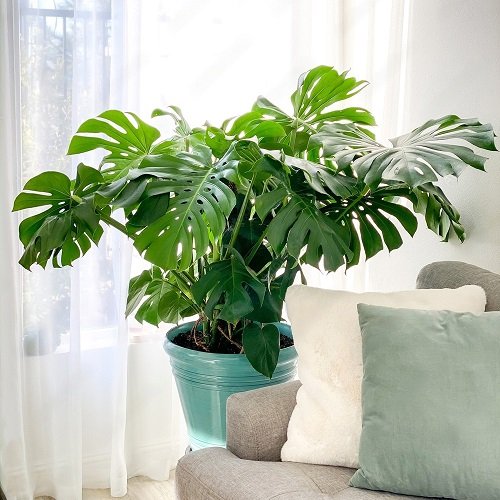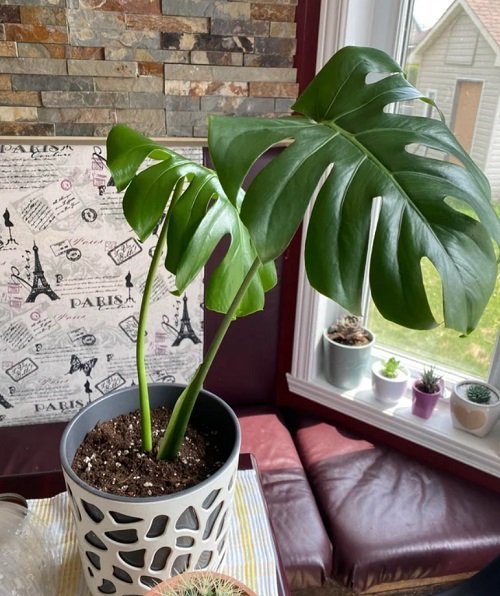
How Cold Monstera Can Tolerate
How cold Monstera can Tolerate? Learn about the Monstera’s temperature resilience and shield it from cold stress. Ensure your Swiss cheese plant thrives year-round with vital care tips.

Dive deeper into the nuances of the Monstera plant’s cold tolerance. Explore the key variables that impact how these tropical plants withstand chilly conditions, and gain insights into providing optimal care to maintain their lush foliage even when temperatures drop.
About Monstera
Monstera, scientifically known as “Monstera deliciosa”, is a popular tropical plant renowned for its distinctive split and fenestrated leaves, resembling Swiss cheese. Native to the rainforests of Central and South America, particularly in regions like Mexico, Panama, and Colombia, Monstera plants have gained widespread popularity as indoor and decorative foliage.
While Monstera is a tropical plant, it is sensitive to cold temperatures. Exposure to temperatures below 50°F (10°C) for extended periods can lead to leaf damage and stress. Protecting them from cold drafts is essential for their well-being.
Can Monstera Plant Survive Outside Over Winter?
As the air turns crisp and the landscape transforms under the influence of winter, the question arises: Can the beloved Monstera plant weather the seasonal shift when placed outside?
Monstera deliciosa, recognized for its distinctive split leaves resembling Swiss cheese, is native to tropical regions and is well-suited to the warmth of its natural habitat (typically found in USDA hardiness zones 10 to 11). Yet, for individuals desiring to cultivate thriving outdoor Monstera specimens during the milder months, comprehending their winter survival potential becomes paramount.
Monstera plants are not inherently cold-tolerant. Exposing them to frost or extended periods of low temperatures can lead to significant damage. The threshold for cold exposure typically hovers around 50°F (10°C). Anything lower than this can trigger stress responses such as leaf discoloration and slowed growth.
How cold is too cold for monstera plants?
Monstera plants, native to tropical climates, possess a limited tolerance for cold temperatures. Typically, when the thermometer drops below 50°F (10°C), Monstera plants become susceptible to adverse effects. Extended exposure to colder conditions can give rise to problems such as leaf discoloration, sluggish growth, and heightened stress. Consequently, safeguarding your Monstera from temperatures below this threshold is paramount, especially in regions with cooler climates.
On the other hand, maintaining the optimal temperature for your Monstera plants is a fundamental facet of their care. When nurtured indoors, they flourish within a temperature span of 64 to 75 degrees Fahrenheit (18 to 24 degrees Celsius).
It’s intriguing to note that despite their capacity to tolerate a moderate temperature range, Monstera plants remain sensitive to extremes—both high and low temperatures. Thus, fostering a stable and comfortable environment for your Monstera becomes pivotal, ensuring their sustained vitality and well-being.
Optimal Temperature and Humidity Conditions for Indoor Monstera Care

Creating the ideal environment for your indoor Monstera plant involves carefully considering temperature and humidity levels. Maintaining the right conditions is essential for its health and growth.
Temperature:
Monstera plants flourish in temperatures spanning from 18 to 24 degrees Celsius (64 to 75 degrees Fahrenheit).
Humidity:
Being native to tropical regions, Monstera plants enjoy higher humidity levels. Aim for a humidity range of 50% to 60%. You can achieve this by misting the plant, using a humidity tray, or placing a humidifier nearby.
Balancing these factors ensures your indoor Monstera flourishes, mimicking its natural habitat for optimal health and lush foliage.
What is a stable winter temperature for monstera plants?
A stable winter temperature is crucial for the well-being of Monstera plants (Monstera deliciosa), particularly considering their tropical origins. Generally, the preferred temperature range for Monstera during the winter months is around 64 to 75 degrees Fahrenheit (18 to 24 degrees Celsius). This moderate temperature range mimics the conditions they would encounter in their natural habitat.
Exposing Monstera plants to significantly lower temperatures, especially below 50°F (10°C), can result in adverse effects such as leaf discoloration, slowed growth, and stress. Cold drafts and sudden temperature fluctuations should be avoided to prevent these issues.
To ensure a stable winter temperature for your Monstera, consider these tips:
Indoor Placement: If you’re keeping your Monstera indoors during the winter, choose a spot away from drafty windows and heating vents. This helps maintain a consistent temperature around the plant.
Avoid Cold Drafts: Cold drafts can be detrimental to Monstera plants. Ensure that windows and doors are properly sealed to prevent chilling air from reaching your plant.
Temperature Monitoring: Consider using a thermometer to monitor the temperature around your Monstera. This can help you make adjustments if needed.
Supplemental Heating: If you live in an area with particularly cold winters, providing supplemental heating in the room where your Monstera is located can help maintain a stable temperature.
By providing a stable and suitable winter temperature for your Monstera, you’re creating a conducive environment for its growth and well-being, ensuring that it remains vibrant and healthy throughout the colder months.
When is the appropriate time to transition my Monstera plants indoors for the winter?

As winter approaches and temperatures begin to drop, it’s advisable to bring your Monstera plants indoors before consistent cold spells below 50°F (10°C) occur. Be attentive to weather forecasts and any signs of stress on the leaves. For container-grown Monstera, relocating them near a well-lit window ensures continued light exposure. If your Monstera is in the ground, consider providing temporary protection or covering on colder nights. Prolonged exposure to cold can harm Monstera plants, so planning for their transition indoors safeguards them during winter.
Monstera Leaf Behavior in Winter and Winter Care Tips
During winter, Monstera plants (Monstera deliciosa) often exhibit changes in leaf behavior due to reduced light and cooler conditions. Leaves might grow more slowly, and some older leaves could turn yellow or brown. To care for your Monstera during this time:
- Light: Place it near a bright, indirect light source to compensate for lower natural light.
- Temperature: Protect it from temperatures below 50°F (10°C) and avoid drafts.
- Watering: Adjust your watering frequency, letting the soil partially dry between waterings.
- Protect Against Drafts: Shield the plant from cold drafts to prevent stress.
- Monitor Soil Conditions: Adjust watering to keep the soil moderately moist, not soggy.
- Check for Pest Infestation: Inspect the plant regularly for pests like spider mites or mealybugs.
- Humidity: Maintain humidity levels around 50-60% using misting or a humidity tray.
- Pruning: Trim damaged leaves to encourage new growth.
By addressing these factors, you can ensure your Monstera remains healthy and resilient during the winter months.
The Monstera Plant in Its Natural Habitat
Also referred to as the split-leaf philodendron, the Monstera plant originates from the lush rainforests of Central and South America. Thriving in tropical and warm climates, this resilient plant is adaptable enough to survive in sub-tropical regions as well.
Found in the heart of tropical rainforests, the Monstera enjoys a habitat where it receives ample water, dappled sunlight, and the support of surrounding trees. The environment is enriched by the contribution of fallen leaves and small stems, acting as organic fertilizers for the Monstera’s growth.
In its native, warmer forest regions, the Monstera can reach towering heights of up to 60 feet, driven by its vigorous growth. However, its rapid expansion has also labeled it as an invasive species in certain areas.
The fascinating aspect is that you can recreate a similar environment indoors or outdoors in your living space, allowing this versatile plant to thrive.
Do Monstera plants produce new leaves during the winter season?
Monstera plants (Monstera deliciosa) typically exhibit a slow rate of leaf growth during the winter season. The main reasons for this reduced growth are low light levels and cool temperatures.
Although it is not unusual for monstera plants to produce new leaves in winter, the growth process may occur more slowly than in the warmer months. The plant’s energy is often directed toward maintaining its existing foliage and adjusting to seasonal changes in its environment.
To aid in healthy leaf development during the winter, it’s important to make sure your monstera still gets enough light. Placing it near a well-lit window or supplementing it with artificial light can help provide the energy needed for leaf growth. Additionally, maintaining consistent care practices, such as proper watering and humidity levels, will contribute to your monstera’s overall well-being, even during the winter months.
Winter Pruning for Monstera Plants

Trimming a Monstera plant (Monstera deliciosa) during winter necessitates a measured strategy to maintain its health and appearance. Here’s a concise guide for winter pruning:
- Purposeful Pruning: Assess the plant’s condition, focusing on removing damaged, yellowing, or diseased leaves. Determine your desired outcome for size and shape.
- Select Pruning Tools: Utilize sanitized pruning shears to ensure clean cuts that minimize damage.
- Timing Matters: Winter is a time of reduced growth, making it suitable for light pruning. Avoid major cuts that could hinder the plant’s recovery.
- Targeted Cuts: Trim close to the base, just above a node where leaves emerge. This encourages new growth.
- Avoid Over-Pruning: Limit trimming to a few leaves or stems. Reserve more extensive pruning for spring or early summer.
- Encourage Vigor: Trim above nodes with new growth to promote bushier foliage.
- Maintain Proportions: For size control, trim longer stems back by a third, guiding growth direction.
- Clean, Careful Cuts: Make precise cuts at a slight angle to prevent water accumulation and potential disease.
- Post-Pruning Care: Monitor the plant for a week or two, ensuring it responds positively to the pruning.
Remember, winter pruning for Monstera plants should be conservative to respect their seasonal growth patterns. By following these guidelines, you can uphold the plant’s well-being and aesthetics throughout the colder months.
Do You Feed Monstera in Winter?

Feeding Monstera plants during winter is a subject of consideration. The reduced light and slower growth rates often mean that their nutrient requirements are lower. Some gardeners choose to reduce or suspend feeding during this period, while others opt for a more diluted and infrequent feeding regimen. Ultimately, assessing your Monstera’s condition and response to feeding can help determine the best approach for its winter care.
Conclusion
Addressing the specific wintering needs of monstera plants is essential to their well-being. Maintaining proper temperature, humidity, and lighting conditions, as well as monitoring changes in leaf behavior, will contribute to their successful winter care. Adapting your care routine to reflect their natural habitat ensures a healthy and thriving monstera in the colder months, well positioned for vigorous growth in the seasons to come.






Average Rating